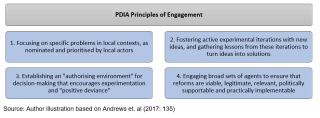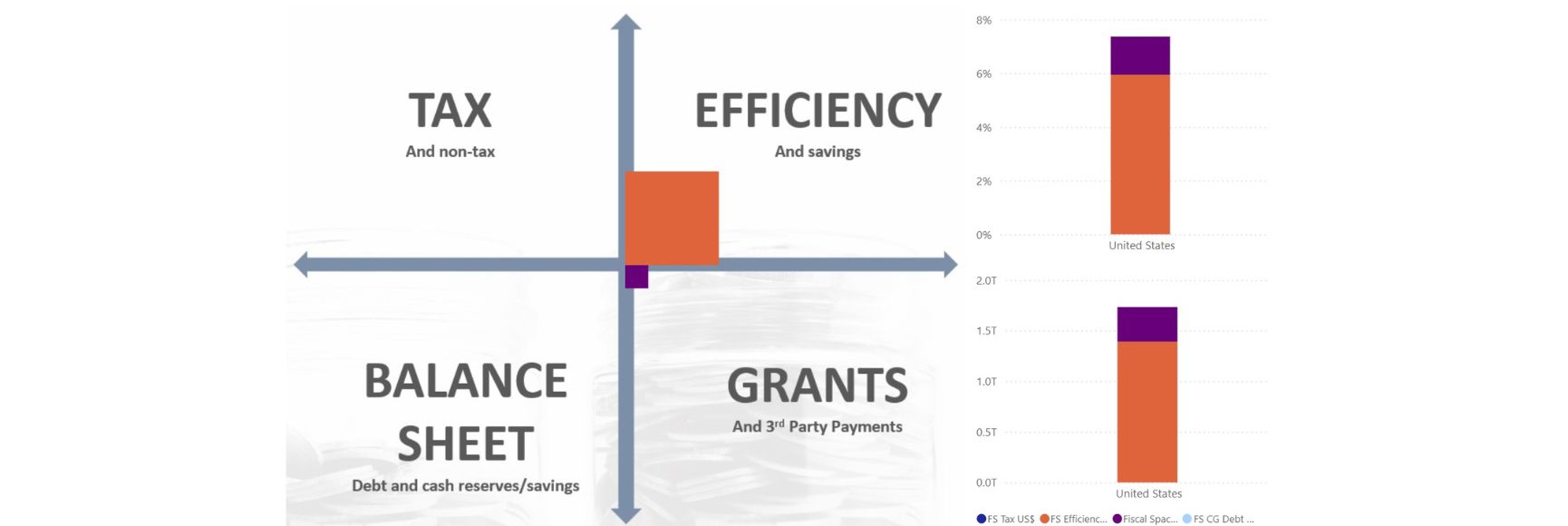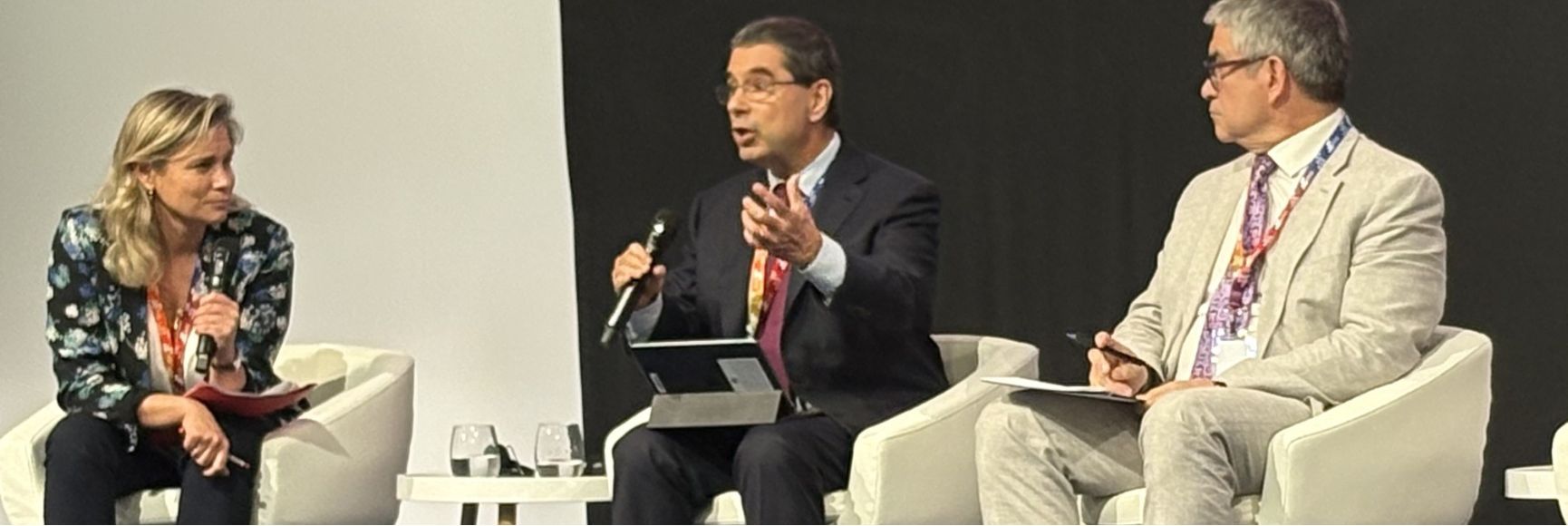Posted by Jamelia Harris and Andrew Lawson[1]
Building State Capability: Evidence, Analysis, Action by Matt Andrews, Lant Pritchett and Michael Woolcock sets out the Problem Driven Iterative Adaptation (PDIA) approach and how this can be implemented to tackle complex or “wicked hard” problems. It comprises four “principles of engagement” (Figure 1). Importantly, PDIA is locally driven and predicted to lead to better results compared to the importation of international best practices.
Figure 1: PDIA principles of engagement
In reviewing the book, Richard Allen suggested five points that were left unanswered: (i) unrepresentative case studies; (ii) unclear distinction between problems and solutions; (iii) ambiguity of terms integral to the PDIA approach; (iv) significant time commitments required from local staff; and (v) the possibility of PDIA being a technical response to fundamentally political problems. These points raised questions over the ability of the PDIA approach to regularly generate successful results.
In 2017, the Collaborative Africa Budget Reform Initiative (CABRI) launched its first application of the PDIA approach through the Building PFM Capabilities (BPFMC) in Africa Programme. In 2018, another six country teams participated. The 2018 cohort - Central African Republic, Côte d’Ivoire, Ghana, Lesotho, Liberia and Nigeria – was evaluated by consultants from FISCUS, thus providing a set of representative case studies of the application of PDIA. Joana Bento summarised three key lessons from this evaluation giving evidence of areas of success for PDIA, but leaving unanswered some of Richard Allen’s concerns. As members of the evaluation team, we here address these concerns based on the evidence from the evaluation.
What works well
Bento noted the importance of (i) problem identification, (ii) experimentation, and (iii) building teams and institutions, as key lessons in favour of PDIA. We add two success factors to the list:
- The PDIA approach is a catalyst for local skills development. In the six countries, there is strong evidence of the development of skills in problem-solving, team-working, adaptive learning and reform implementation. Skills development can be largely attributed to the guidance and support received during the eight-month BPFMC cycle. Follow-up data five months after the end of the cycle indicate that skills development can be sustained and diffused to other groups. Several participants were able to describe how they were using PDIA techniques in other ongoing reforms. Skills development is closely related to improved self-confidence. A common message emerging from the studies was that PDIA empowered the participants to tackle their own problems. Increased self-confidence matched by improved skills may be key to the design and implementation of sustainable PFM reforms.
- Progress was made towards the resolution of complex PFM problems in the short run. An eight-month cycle will not solve the most complex problems but in three of the six countries, there was evidence of progress toward the identification of solutions. In these cases, there was increased senior level attention to reform blockages, and more tangible successes like establishing protocols and guidelines, and integrating new reports into the budget cycle. In one case, efforts culminated in a significant improvement in budget execution for investment projects.
Likely conditions for success
As Richard Allen contended, the evaluation confirmed that case selection, staff time commitments, and the political nature of problems are critical. In the three cases that showed the most promising progress, there were three common features:
- Team capability and time on task: Teams that comprised local staff with a range of experience and expertise, who – importantly – were able to dedicate adequate time to the BPFMC programme, performed better. However, as noted by Richard Allen, such time demands are not always practical and feasible when challenged by other commitments. Indeed, the less successful teams struggled to maintain high levels of engagement with the BPFMC programme alongside day-to-day tasks.
- Choice and definition of the problem (political vs technical): Teams that had well defined problems and identified several entry points to those problems, made more progress, as did problems that were largely technical rather than political. This implies (so far) that “wicked hard problems” may still elude the PDIA approach without full political commitment, similar to other reform approaches.
- The authorising environment: Political commitment can be garnered through having a strong authorising agent in the PDIA framework and subsequently expanding the authorising environment. The most successful case reviewed – Central African Republic – had a strong authorising environment. Two of the three countries that made little progress, scored poorly on this criterion. The ability to expand the authorising environment interacts with the issues above: it is easier with a stronger team, and a less politically sensitive problem.
Conclusions on the role of PDIA in the PFM reform agenda
Through the CABRI BPFMC programme, PDIA has proven itself to be a valuable instrument in the PFM reform toolkit. It is useful in identifying problems, teasing out critical blockages, and developing local capabilities to drive reforms. These contributions are important and may be essential for PFM reforms to be sustained. But PDIA is not a silver bullet: it is not yet clear that it would be a useful tool in addressing politically sensitive problems. In many contexts PDIA might become more effective in combination with other approaches to PFM reform.
In sum, we are optimistic about the potential of PDIA, mindful of its limitations, and hopeful that there will be a wider take-up of PDIA alongside other reform approaches.
[1] FISCUS, Public Finance Consultants, UK.
Note: The posts on the IMF PFM Blog should not be reported as representing the views of the IMF. The views expressed are those of the authors and do not necessarily represent those of the IMF or IMF policy.







